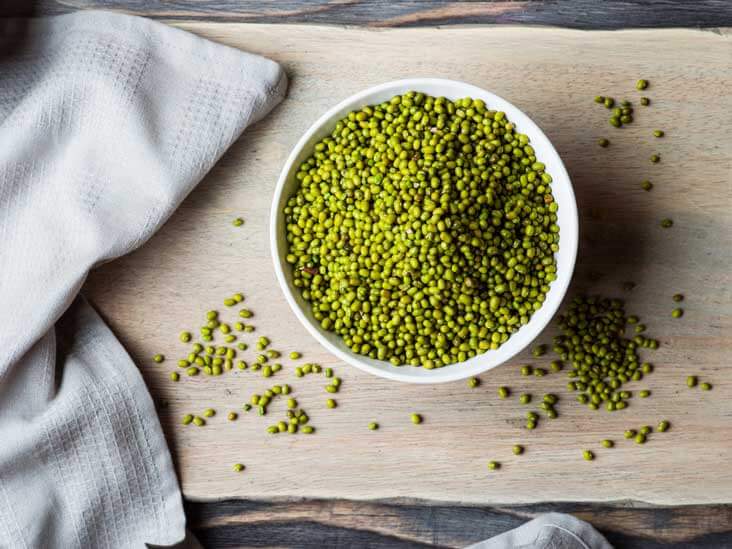
The seeds (sprouts) for mung bean plants are germinated mung beans. The pods, which contain the sprouts, are very low in calories but very high in nutrients. So, nutrition scientists call them a leafy vegetable. For culinary and marketing purposes, the pods are only allowed to grow until the establishment of the first root (radicle), skipping over any further growth into a tiny plumule (baby greens).
Scientific name: Vigna radiata.
Mung bean seeds come in a variety of colors. They’re usually green, but can also be yellow, or brown. The seeds are shaped like kidney beans with a long handle. Mung bean pods grow to about 10 centimeters long and have about 10-15 seeds inside each one.
Health benefits of Mung bean Sprouts
Mung beans take on their nutrients and colors through the sprouting process, so they’re very nutritious and low-calorie foods. Their calorie value compared to their seed counterparts is comparable to leafy greens like spinach. The fiber content in sprouted mung beans is also high, making them a healthy food choice. Mung bean sprouts offer benefits like detoxification and cancer protection, as well as being gluten free.
Sprouting steps
Germination expand the seed size to near about three times its original size. Once beans have sprouted, they can be stored in the refrigerator to prevent further growth. Some things to keep in mind before starting your inquiry here at our company would include choosing quality seeds, and washing them for debris or grit well. Allergic reactions are rare but possible, so please make sure you are not allergic before starting this a few days of germinating beans.
Selection and storage
The best way to purchase bean sprouts is by visiting the fresh-produce section at your local grocery store. Look for packs that are firm and long, with smooth-looking green leaves. You can also check out online retailers or find them at your local farmers’ market. The difference between a new pack of bean sprouts and an old one is that the new pack will likely have healthier looking leaves. Make sure you’re buying in-date packs so you don’t need to worry about foodborne diseases or spoilage risks with frozen sprouts bags.
When purchasing mung bean sprouts, it’s important to make sure that they are fresh. Look for firm and long radicles, as well as a plump appearance. Check the date of packing, expiration date, and haven’t turned brown or changed colors. Store them in your fridge at 5 degrees Celsius. So they last a bit longer than 2 days without having to use the sprouts themselves. The NHS-Food Standards Agency says “you should not eat sprouts that are past their use by date and should avoid using sprouts that have turned brown or changed color”.
Preparation and serving methods
When storing mung bean sprouts, be aware that some of the vegetative compounds are released when wet. Soak them in water and drain, then let them dry in a warm (70 degrees Celsius) area to prevent a muddy taste. Mung bean sprouts are great in stir-fries, Asian salads and appetizers like the classic ‘chop suey.’
Store your sprouts at proper temperatures and in dry places with decent ventilation, so that they can continue to grow while being stored. Proper storage of beans also prevents the metabolite from releasing during the storing process, which would otherwise lead to their deterioration. The mung bean is best known in the USA, where it is used primarily in salads and Asian-styled dishes. Chop suey has become a popular dish in American Chinese cuisine, made with very thinly chopped cabbage and prepared with a starch-thickened sauce that incorporates an omelet. In Japan, China, and South-East Asian regions, mung beans are often used as an ingredient for stir-fries.
Safety profile
Mung bean sprouts are more easily digested and rarely cause odor problems than other vegetables. But if you’re pregnant or have a compromised immune system, you should avoid eating sprouts past their use-by date, or suffer potential complications.
Mung bean sprouts pack a nutritional punch with an in-depth level of nutrients. They’re also natural energy boosters, making them easy to digest while they go relatively unnoticed when they’re consumed. However, you should not eat sprouts that are past their use by date and avoid using sprouts that have turned brown or lost their color.







